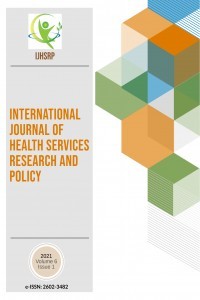AN OVERVIEW OF PERIOD POVERTY AND THE PUBLIC HEALTH BENEFIT IMPACT OF PROVIDING FREE FEMININE HYGIENE PRODUCTS
AN OVERVIEW OF PERIOD POVERTY AND THE PUBLIC HEALTH BENEFIT IMPACT OF PROVIDING FREE FEMININE HYGIENE PRODUCTS
Period poverty Feminine Hygiene Products, Public health, New York City, Cost-Effectiveness,
___
- Montano E., “The Bring Your Own Tampon Policy: Why Menstrual Hygiene Products Should Be Provided for Free in Restrooms,” University of Miami Law Review, 73(1), 370-410, 2018.
- Hartman V., “End the Bloody Taxation: Seeing Red on the Unconstitutional Tax on Tampons,” Northwestern University Law Review, 112(2), 313, 353, 2017.
- Bridget J. Crawford B., Waldman E.G, “The Unconstitutional Tampon Tax,” in Elısabeth haub school of law faculty publıcatıons, pp. 439-489, 2019.
- Tucker J., and Lowell C, “Natıonal snapshot: poverty among women & famılıes, 2015,” in National Women’s Law Center, Sep. 2016. https://nwlc.org/wp-content/uploads/2016/09/Poverty-Snapshot-Factsheet-2016.pdf
- Bennett J., “The Tampon Tax: Sales Tax, Menstrual Hygiene Products, and Necessity Exemptions,” The Business, Entrepreneurship & Tax Law Review, 1(1), 183-215, 2017.
- Carroll L, “Even in the U.S., poor women often can’t afford tampons, pads,” Reuters, Jan. 10, 2019. https://www.reuters.com/article/us-health-menstruation-usa/even-in-the-u-s-poor-women-often-cant-afford-tampons-pads-idUSKCN1P42TX
- McMahon S.A., et al., “‘The girl with her period is the one to hang her head’ Reflections on menstrual management among schoolgirls in rural Kenya,” BMC International Health and Human Rights, 11(7), 1-10, 2011.
- Mason L., et al., “’ We keep it secret so no one should know qualitative study to explore young schoolgirls attitudes and experiences with menstruation in rural western Kenya,” PLoS One, 8(11), e79132, 2013, doi: 10.1371/journal.pone.0079132.
- Hennegan J, et al., “Women’s and girls’ experiences of menstruation in low- and middle-income countries: A systematic review and qualitative metasynthesis,” PLoS Medicine, 16(5), e1002803, 2019, doi: https://doi.org/10.1371/journal.pmed.1002803.
- Sommer M. et al., “A Time for Global Action: Addressing Girls’ Menstrual Hygiene Management Needs in Schools,” PLoS Medicine, 13(2), 1-9, 2016, doi: https://doi.org/10.1371/journal.pmed.1001962.
- Scandurra L., et al., “Cambodian boys’ transitions into young adulthood: exploring the influence of societal and masculinity norms on young men’s health,” Culture, Health & Sexuality, 19(7), 767–780, 2017, doi: https://doi.org/10.1080/13691058.2016.1259504.
- Schmitt M.L., et al., “Making the Case for a Female-Friendly Toilet,” Water, 10, 1-9, 2018, doi: https://doi.org/10.3390/w10091193.
- O’Connor R., “Menstruation study finds over 5,000 slang terms for ‘period,’” Independent, Mar. 01, 2016. https://www.independent.co.uk/life-style/health-and-families/menstruation-study-finds-over-5-000-slang-terms-period-a6905021.html
- Ruiz-Grossman S., “Unanimous Vote Brings Free Tampons To NYC’s Schools, Prisons, Shelters,” HuffPost, Jun. 21, 2016. https://www.huffpost.com/entry/free-tampons-law-new-york-schools-prisons-shelters_n_57697b43e4b0a75709b7ea1a
- Ruiz-Grossman S., “NYC Mayor Signs Free Tampons For Schools, Jails, Shelters Into Law,” HuffPost, Jul. 14, 2016. https://www.huffpost.com/entry/new-york-city-mayor-bill-de-blasio-signs-tampons-free-law_n_5787bc57e4b08608d3336b27
- Das P., et al., “Menstrual Hygiene Practices, WASH Access and the Risk of Urogenital Infection in Women from Odisha, India,” PLoS One, 10(6), e0130777, 2015. doi: https://doi.org/10.1371/journal.pone.0130777.
- Phillips-Howard P.A., et al., “Menstrual cups and sanitary pads to reduce school attrition, and sexually transmitted and reproductive tract infections: a cluster randomised controlled feasibility study in rural Western Kenya,” BMJ Open, 6(11), e013229, 2016. doi: 10.1136/bmjopen-2016-013229.
- Stolz A. Et al., “An improperly positioned menstrual cup complicated by hydronephrosis: A case report,” Case Reports in Women’s Health, 22, e00108, 2019.
- Kulczyk Foundation, “A Bloody Problem: Period Poverty, Why We Need to End it and How to Do It,” 2020. https://kulczykfoundation.org.pl/uploads/media/default/0001/05/465728000cda27b8f50a3acc18d77c7b4df8b482.pdf
- “The period tax around the world,” My period is awesome, 2020. Wise Economy Global Association, https://www.myperiodisawesome.com/blog/period-tax-around-the-world
- Keck M.,, “This Australian State Will Experiment With Free Pads and Tampons in All Public Schools,” Global Citizen, Mar. 04, 2021. globalcitizen.org/en/content/new-south-wales-free-period-products-schools/?template=next
- Taylor L., “Scotland Becomes First Country in the World to Make Period Products Free,” Global Citizen, Nov. 25, 2020. https://www.globalcitizen.org/en/content/scotland-first-country-free-period-products/?template=next
- Ainge R. E., “New Zealand tackles ‘period poverty with free sanitary products for all schoolgirls,” The Guardian, Jun. 03, 2020. https://www.theguardian.com/world/2020/jun/03/new-zealand-tackles-period-poverty-with-free-sanitary-products-for-all-schoolgirls
- World Bank Group, “Changing the Lives of Women and Girls through Affordable Feminine Hygiene Products,” Jun. 2017. https://www.innovationpolicyplatform.org/www.innovationpolicyplatform.org/system/files/6_Health%20Female%20Hygiene%20Case_Jun21/index.pdf
- Moradi F., et al., “The effectiveness of counseling based on acceptance and commitment therapy on body image and self-esteem in polycystic ovary syndrome: An RCT,” International Journal of Reproductive BioMedicine, 18(4), 243–252, 2020, doi: 10.18502/ijrm.v13i4.6887.
- Yayın Aralığı: Yılda 3 Sayı
- Başlangıç: 2016
- Yayıncı: Rojan GÜMÜŞ
THE RELATIONS BETWEEN FEAR OF COVID-19, ANXIETY OF DEATH, AND MEANING OF LIFE AMONG NURSING STUDENTS
Sebahat ATEŞ, Havva KAÇAN, Fatma AYHAN, Azzet YÜKSEL
BASIC PARAMETERS OF LENS DESIGN
Alev YILDIRIM KESKİN, Sibel ŞENTÜRK, Zeynep Büşra TEKE
Udit DAVE, Ashwin PALANİAPPAN, Emma LEWİS, Brandon GOSİNE
Bilal İLANBEY, Duygu ZORLU, Hacı Mehmet ÇALIŞKAN, Zamir Kemal ERTÜRK, Burak ÇELİK, Süleyman ERSOY, Kenan GÜÇLÜ
ASSOCIATION BETWEEN RISK FACTORS AND COGNITIVE IMPAIRMENT AMONG TYPE 2 DIABETES MELLITUS PATIENTS
Mir ABDUL MUNİF, Laxman VERMA, Malik FAİZAN AHMAD, Anas Ahmad KHAN, Ankıt SİNGH
Djıeukap LAURELLE, Herman Parfait AWONO-AMBENE, Christophe ANTONİO-NKONDJİO, Bienvenu BALİFELİ, Chi Tchampo FRU, Cyrille NDO, Nicolas Félicien DOLOGUELE, Serge Hubert ZEBAZÉ TOGOUET, Flobert NJİOKOU
ASSOCIATION BETWEEN PSYCHOLOGICAL UPSET AND IRRITABLE BOWEL SYNDROME AMONG NURSING STUDENTS AT KSA
